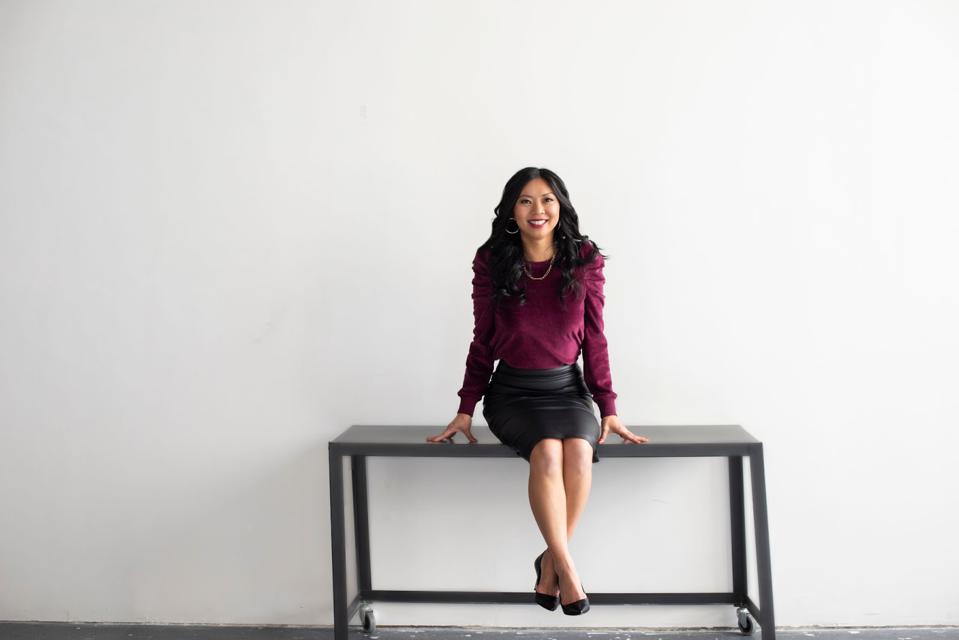This 7-Figure Entrepreneur Is Betting On The Creator Economy—And Winning | Stephanie BurnsWENDY YALOM
Fifty million and growing. That’s how large the creator economy is, according to recent research by venture capital firm SignalFire. From health practitioners to Instagram influencers, this group of content creators, curators and community builders are mastering the art of monetizing their talents—and marketing expert and launch strategist Destinee Berman is helping them do it.
“For so long people have been wondering how to build a career around their passion,” says the former Silicon Valley director who now specializes in helping offline business owners, entrepreneurs, experts and educators market and launch their online courses. “We’ve come to a time in history now when making a living off of your passion is possible. This opportunity hasn’t existed before but the creator economy opened up so many options.” Through her programs, Destinee has directly taught hundreds of students in 23 countries across the globe and her clients have used her techniques to generate more than $17M from launches.
“I’m going all out creating content myself while building my business around creators who want to build businesses,” says Berman, who is on pace to hit the multi-seven figure mark this year. She also has a YouTube channel and invests in a San Francisco company that supports the creator economy. “I’m passionate about aligning your business with your creative calling,” she says.
I sat down with Destinee to ask her about how she springboarded from corporate to a successful online business, what the future of the creative economy is, what everyone gets wrong about online courses and how to own your expertise as a female entrepreneur.
Stephanie Burns: How did you get started in your career?
Destinee Berman: Entrepreneurship was in my DNA. As a child of Chinese immigrants, I watched my parents earn a lot and lose a lot through serial business ventures and bad decisions. My father would lose a lot of money investing in, say, a janitorial business but then make a lot in a multilevel marketing wellness business. To this day I can tell you about the five elements of Traditional Chinese Medicine and explain how supplements work because I did sales presentations for them starting at the age of 13. It was scary stepping up to the microphone at first, but I found that I loved speaking and teaching.
The ups and downs of that lifestyle must’ve felt traumatic because I initially rejected entrepreneurship and opted for a safe job in marketing in tech. Then the company where I worked got acquired. There were promotion opportunities but they just didn’t feel exciting. There was something inside of me pulling me in a different direction. I decided to give myself a six month sabbatical to figure out what I should do next and it led me back to my passion for speaking and teaching.
Burns: During your six-month break, how did you hit the ground running and create your own seven-figure company?
Berman: I did a lot of research on the online landscape and participated in a lot of trial and error. I had a new idea every week. At first, I did 200 hours of yoga training and thought I wanted to introduce the yogi mindset to corporates. Then I decided to help women reinvent themselves—while I was reinventing myself. I even co-created an online course and while I learned a lot about what it takes to succeed in that space, less than five people signed up for it. I spent a lot of time feeling around in the dark. The most important things I did, though, were watching a lot of webinars, doing research and figuring out what my strengths were. The webinars made me realize that online courses were definitely the future; and analyzing my strengths reminded me that I needed to focus on marketing.
I started cold pitching business owners in the mind-body space who were looking for help launching courses. I could see this was an underserved demographic. I was able to harness all of the marketing skills I’d learned supporting companies like Twitter, HP and Microsoft to help them create online courses in their areas of expertise so they weren’t solely reliant on their profits from in-person teaching. I got to six figures in my first six months of business by building a revenue split into my consulting payments so I was essentially betting on myself—and winning. That was my first experience supporting the creator economy. From there referrals came in like crazy and I didn’t have to look for clients at all.

WENDY YALOM
Burns: What exactly is the creator economy?
Berman: It’s not the gig economy. It’s a business model that allows people to unbundle from traditional employment and still be successful. A creator is anyone who is taking their knowledge, experience and training to create content and offer education online. You can be a creator whether you’re a physician, an artist, an astrologer, a therapist, a YouTube influencer or a video producer. The economy is exploding because there are more ways than ever before to make money off of your skills now—like physical products, partnerships, writing and, most important, digital courses. You don’t need tens of thousands of followers to do so. You can bring in six figures a year with a small group of true fans.
One of the first things people ask me about the creator economy is if it’s oversaturated. It’s not. And it’s not too late to get in. But you have to focus on making your messaging and your positioning as crisp as possible and meeting a need not a nice-to-have. The secret to success when you’re starting out in the creator economy is to be like Amazon, Uber and Bombas. Start out fulfilling one niche need, like books, black cars and socks. Then as your business grows, you can expand your offerings.
Burns: You’re a big fan of creatives using online courses to monetize their passion, but what are some mistakes you see entrepreneurs making when they try to do this?
Berman: So many entrepreneurs believe that you should sell your course before you create it. But I tell my students that they should be marketing and developing their course in parallel. When you’re in launching mode, there will be questions people ask. If this is your first program, these questions will be useful and you can add them into the program. At the same time, you want to make sure you’re attracting the right people to your course. So you want to be sure of the content while you’re marketing it.
Another huge mistake I’ve seen is undercharging people for your course because you’re basing the price on the content delivered and not the transformation achieved. If your clients care about reducing anxiety, don’t charge them based on how many modules you offer, pick a price based on what living an anxiety-free life would mean to them. You can look at other courses in your area of expertise and see what they’re charging, but, ultimately, if you want to charge more, you should do so for getting your students to their desired outcome faster. Not because you have more modules.
One last thing that trips people up is losing faith before your cart closes. Putting your course online isn’t like holding a Black Friday sale. People may not break down the doors to get in the second you open up. I often see a significant number of sales come in on the last day of carts being open. Don’t waste energy losing hope. Get excited for what’s to come.

WENDY YALOM
Burns: So many people worry that creating an online course will take a lot of time or drain their energy, but you’ve found a way around that?
Berman: I’ve created the Skinny Launch™ method that gets your course up and running in just 90 days. The beauty of getting your idea to market swiftly is that it not only allows you to eliminate the overwhelm so many entrepreneurs experience around launches but it also enables you to start making money off of your ideas quickly. You’ll be able to get rapid feedback about what your customers want more of so that your next launch will be even better. Then you just rinse and repeat.
If anything, what takes time is building relationships at scale. Whether it’s organic or paid, you always need to be feeding the engine so that you have new people you can reach out to and sell to. I encourage my students to engage in what I call “heavy nurturing” to create deep know, like and trust with their audience for a period of six to eight weeks before launching. That makes it easier for you to get a “yes” when you reveal your offer.
Burns: I know you’re incredibly passionate about helping female entrepreneurs, in particular, own their expertise. Why is that?
Berman: American women lost more than five million jobs last year due to the pandemic—and those who held on to their positions are making on average 81 cents on the dollar compared to their male counterparts. One way to get back in the workforce and level the earning field is by pursuing and owning your calling. By monetizing your expertise, you get to be a full human being (not only a mom, wife or woman). You also get to have a full bank account while doing it, so if you decide you want to buy a $200 bottle of wine, you can do so without hesitation. No matter what circumstances we are given, we can rise above them. I want that true empowerment for women everywhere. I want women to be able to live the kind of lifestyle we want without guilt, full permission.
Article Credit: forbes
